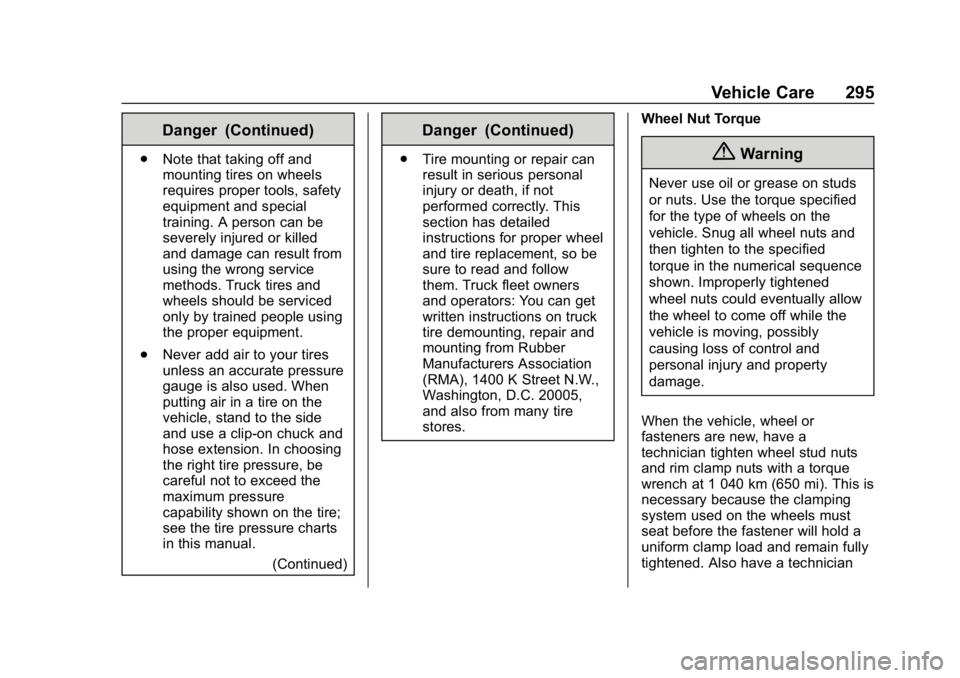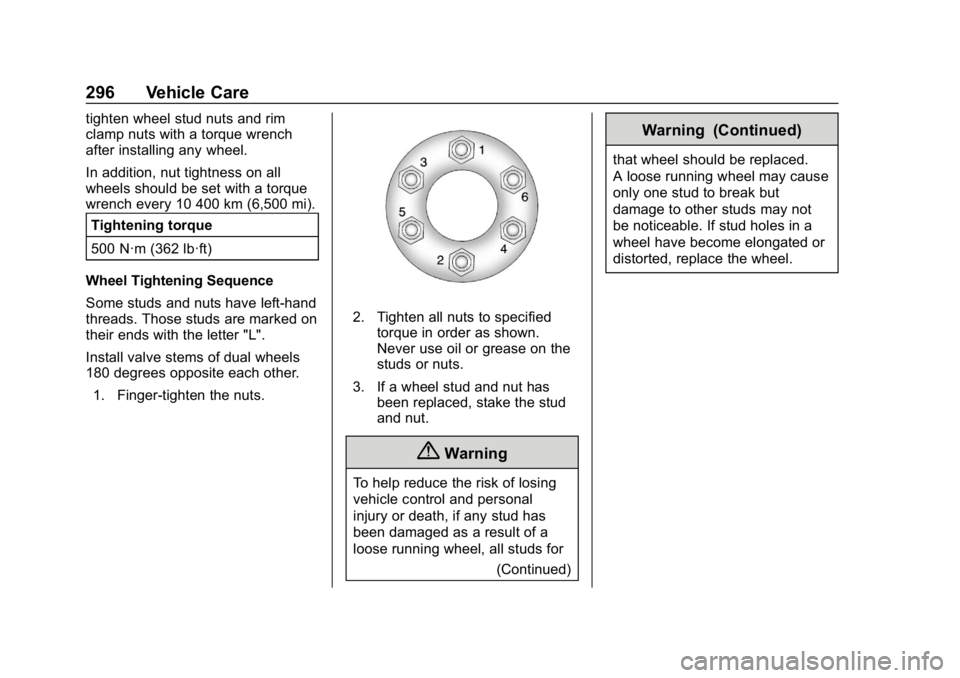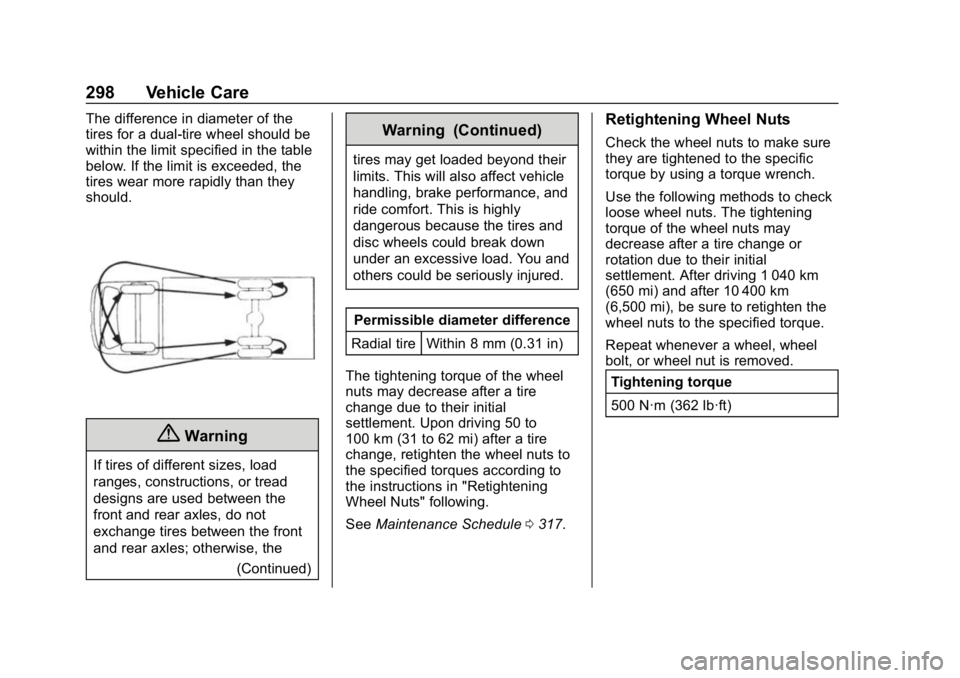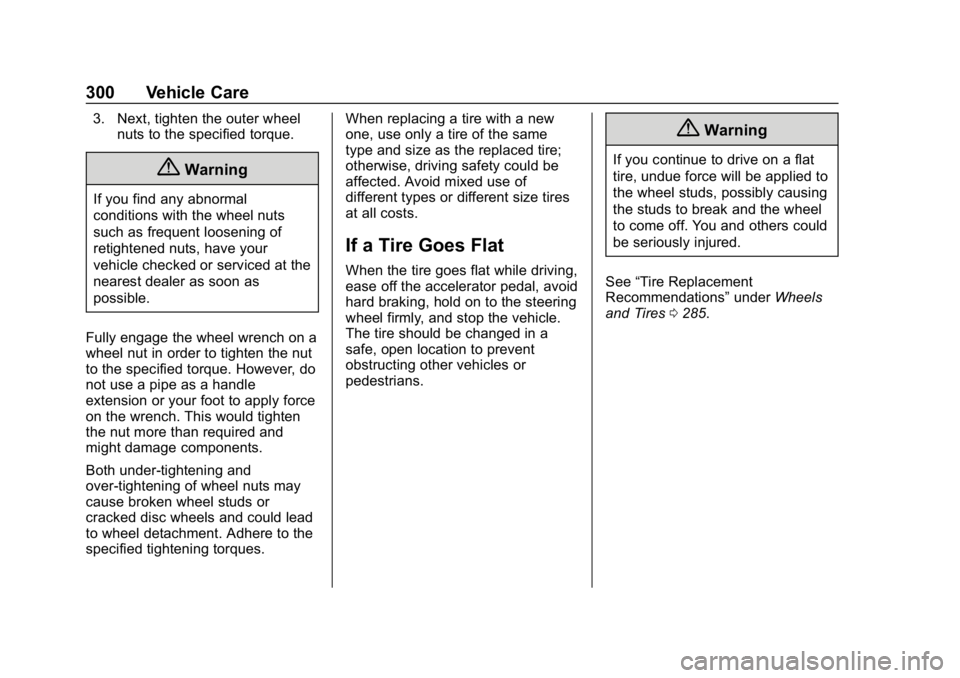warning CHEVROLET LOW CAB FORWARD 2020 Owner's Manual
[x] Cancel search | Manufacturer: CHEVROLET, Model Year: 2020, Model line: LOW CAB FORWARD, Model: CHEVROLET LOW CAB FORWARD 2020Pages: 374, PDF Size: 6.18 MB
Page 290 of 374

Chevrolet Low Cab Forward 5.2L Diesel Engine 4500 HD/XD/5500 HD/XD
Owner Manual (GMNA-Localizing-U.S.-13337621) - 2020 - crc - 12/5/18
Vehicle Care 289
Recommended replacement tire for Greenhouse Gas (GHG) emissions
Tire sizeTire makerTire name Rolling
resistance
LT215/85R16E BRIDGESTONE CORPORATION
M779AZ LRRA
THE YOKOHAMA RUBBER CO., LTD. TY213B LRRA
225/70R19.5F BRIDGESTONE CORPORATION
M895Z LRRA
SUMITOMO RUBBER INDUSTRIES, LTD. (DUNLOP) SP688 LRRA
If the original equipment tires are
low rolling tires, it is recommended
to use the LRRA tires shown in the
above table.
Refer to the emission control
identifiers on Greenhouse Gas
(GHG) emission plate for your
original equipment tires. Also,
please refer to “VIN, Weight Rating,
and Greenhouse Gas (GHG)
Emissions Plate” for the location of
the Greenhouse Gas (GHG)
emission plate. See Vehicle
Identification Number (VIN) 0343. Wheel Replacement
Recommendations
Wheels must be replaced if they
become damaged (for example:
bent, heavily rusted, leak air) or if
wheel nuts often become loose. Do
not use bent wheels that have been
straightened and do not use inner
tubes in leaking wheels which are
designed for tubeless tires. Such
wheels may have structural damage
and could fail without warning.
When replacing wheels for any
reason, the new wheels should be
equal in load capacity, diameter, width, offset and mounting types to
those originally installed in your
vehicle.
A wheel of the wrong size or type
may adversely affect wheel and
bearing life, brake cooling,
speedometer/odometer calibration,
stopping ability, headlight aim,
bumper height, vehicle ground
clearance and tire or tire chain
clearance on the body and chassis.
Replacement with "used" wheels is
not advised. They may have been
subjected to harsh treatment or very
high mileage and could fail without
warning.
Page 291 of 374

Chevrolet Low Cab Forward 5.2L Diesel Engine 4500 HD/XD/5500 HD/XD
Owner Manual (GMNA-Localizing-U.S.-13337621) - 2020 - crc - 12/5/18
290 Vehicle Care
{Warning
Consult your dealer before
replacing wheels. Never use
wheels that are not designed for
the vehicle. Doing so would
impede safe vehicle operation.
The use of wheels and/or tires with
higher load carrying limits than
originally equipped on your vehicle
does not in itself increase the
GAWR or the GVWR of the vehicle.
Replacement wheels can be
obtained from the authorized dealer
or tire dealer.
Checking Tires
Air Pressure
Too low or too high a tire air
pressure not only affects the ride or
causes damage to the cargo but
also causes abnormal heat buildup,
premature wear, a tire puncture,
or may even cause the tire to burst. Use an appropriate tire air pressure
gauge when measuring the air
pressure of a tire. Tire air pressure
should be measured when the tire is
cold, or before the vehicle is driven.
(After driving, tire air pressure
increases by about 10%.)
As the tire air pressure varies
depending on the vehicle model and
tire size, refer to the
“VIN, Weight
Rating, and Greenhouse Gas
(GHG) Emissions Plate” on the
driver's door opening frame or the
tire air pressure information on the
following table.
Page 292 of 374

Chevrolet Low Cab Forward 5.2L Diesel Engine 4500 HD/XD/5500 HD/XD
Owner Manual (GMNA-Localizing-U.S.-13337621) - 2020 - crc - 12/5/18
Vehicle Care 291
Tire sizeTire air pressure
kPa (psi) GVW
kg (lb.)
Front RearFront Rear
LT215/85R16E LT215/85R16E 550 (80)550 (80) 6 577
(14,500)
225/70R19.5F 225/70R19.5F 590 (85)590 (85) 7 258
(16,000)
225/70R19.5F 225/70R19.5F 620 (90)620 (90) 8 142
(17,950)
225/70R19.5F 225/70R19.5F 660 (95)660 (95) 8 845
(19,500)
See “VIN, Weight Rating, and
Greenhouse Gas (GHG) Emissions
Plate” underVehicle Identification
Number (VIN) 0343.
See “Tire Load and Inflation Table”
under Tire Pressure 0297.
{Warning
Insufficiently inflated or worn-out
tires are highly dangerous as they
easily skid and can even burst.
(Continued)
Warning (Continued)
Should they burst, the tires may
burn and this could cause a fire in
the vehicle.
If you drive on under-inflated or
flat tires, the wheel studs will be
placed under excessive stress.
Under such conditions, the bolts
(Continued)
Warning (Continued)
may break and the wheel may
detach from the vehicle, possibly
causing a crash.
Over-inflated tires result in a
harsh ride and are likely to cause
damage to the cargo.
Under-inflated tires build up heat(Continued)
Page 293 of 374

Chevrolet Low Cab Forward 5.2L Diesel Engine 4500 HD/XD/5500 HD/XD
Owner Manual (GMNA-Localizing-U.S.-13337621) - 2020 - crc - 12/5/18
292 Vehicle Care
Warning (Continued)
and could burst. Always keep the
tires of your vehicle adjusted at
the standard air pressures.
You and others could be seriously
injured.
There should not be a difference in
air pressure between the inside and
outside
tires on a dual-tire wheel.
It is not easy to visually identify an
under-inflated dual-wheel tire or low
aspect ratio tire (aspect ratio at
70%). Always use an appropriate
tire air pressure gauge to check the
air pressure of any tire.
If your vehicle is equipped with
aluminum wheels, use an extension
attached to the inner tire valve
together with a standard tire air
pressure gauge or use a special air
pressure gauge when checking the
air pressure of a dual-wheel's
inner tire. Cracks and Other Damage
1. Sidewall surface
2. Gap between inner and
outer tires
3. Tread
Check the tread and sidewall
surfaces of each tire for cracks or
other damage. Especially check the
tread for nails or other metal pieces
embedded in grooves and also the
gap between the inner and outer
tires of a dual-tire wheel for pebbles
lodged in it. When checking tires, pay special
attention to: low air pressure;
pebbles or nails in tread grooves;
cracks or other damage on tire
surfaces; uneven wear; and pebbles
lodged in the gap between tires of
dual-wheel tires.
Tread Depth and Abnormal Wear
Tread Wear Indicator Position
Mark (Example)
Page 294 of 374

Chevrolet Low Cab Forward 5.2L Diesel Engine 4500 HD/XD/5500 HD/XD
Owner Manual (GMNA-Localizing-U.S.-13337621) - 2020 - crc - 12/5/18
Vehicle Care 293
Tread Wear Indicator (Example)
1. Lug pattern
2. Rib pattern
Using worn-out tires is dangerous
because they might have an
increased chance of getting
punctured or bursting while driving.
Check all tires to see if tread wear
indicators appear on their treads
and also check their entire tread for
its depth with a depth gauge to
make sure that the grooves are
deeper than the specified depth.
A tire with tread wear indicators
appearing must be changed. Also,
check the tires for uneven or
otherwise abnormal wear.
{Warning
Tires with excessively shallow
tread grooves will increase the
chance of skidding and, when
driving at high speeds,
hydroplaning. You and others
could be seriously injured.
Hydroplaning occurs when a vehicle
is running at high speeds on a wet
road and a layer of water forms
between the road surface and tires
causing the tires to float on it.
Hydroplaning prevents the driver
from steering correctly and from
slowing down the vehicle with the
brake pedal. Use of Low Aspect Ratio Tires
1. Standard tire
2. Low aspect ratio tire
Low aspect ratio tires for truck
applications (aspect ratio at 70%)
have an air volume 20% to 30%
smaller than that of standard tires.
Therefore, if air begins to leak, low
aspect ratio tires adversely affect
vehicle operation much faster than
standard tires. Check air pressure of
low aspect ratio tires more often
than standard tires using a tire air
pressure gauge.
Page 296 of 374

Chevrolet Low Cab Forward 5.2L Diesel Engine 4500 HD/XD/5500 HD/XD
Owner Manual (GMNA-Localizing-U.S.-13337621) - 2020 - crc - 12/5/18
Vehicle Care 295
Danger (Continued)
.Note that taking off and
mounting tires on wheels
requires proper tools, safety
equipment and special
training. A person can be
severely injured or killed
and damage can result from
using the wrong service
methods. Truck tires and
wheels should be serviced
only by trained people using
the proper equipment.
. Never add air to your tires
unless an accurate pressure
gauge is also used. When
putting air in a tire on the
vehicle, stand to the side
and use a clip-on chuck and
hose extension. In choosing
the right tire pressure, be
careful not to exceed the
maximum pressure
capability shown on the tire;
see the tire pressure charts
in this manual.
(Continued)
Danger (Continued)
.Tire mounting or repair can
result in serious personal
injury or death, if not
performed correctly. This
section has detailed
instructions for proper wheel
and tire replacement, so be
sure to read and follow
them. Truck fleet owners
and operators: You can get
written instructions on truck
tire demounting, repair and
mounting from Rubber
Manufacturers Association
(RMA), 1400 K Street N.W.,
Washington, D.C. 20005,
and also from many tire
stores. Wheel Nut Torque{Warning
Never use oil or grease on studs
or nuts. Use the torque specified
for the type of wheels on the
vehicle. Snug all wheel nuts and
then tighten to the specified
torque in the numerical sequence
shown. Improperly tightened
wheel nuts could eventually allow
the wheel to come off while the
vehicle is moving, possibly
causing loss of control and
personal injury and property
damage.
When the vehicle, wheel or
fasteners are new, have a
technician tighten wheel stud nuts
and rim clamp nuts with a torque
wrench at 1 040 km (650 mi). This is
necessary because the clamping
system used on the wheels must
seat before the fastener will hold a
uniform clamp load and remain fully
tightened. Also have a technician
Page 297 of 374

Chevrolet Low Cab Forward 5.2L Diesel Engine 4500 HD/XD/5500 HD/XD
Owner Manual (GMNA-Localizing-U.S.-13337621) - 2020 - crc - 12/5/18
296 Vehicle Care
tighten wheel stud nuts and rim
clamp nuts with a torque wrench
after installing any wheel.
In addition, nut tightness on all
wheels should be set with a torque
wrench every 10 400 km (6,500 mi).Tightening torque
500 N·m (362 lb·ft)
Wheel Tightening Sequence
Some studs and nuts have left-hand
threads. Those studs are marked on
their ends with the letter "L".
Install valve stems of dual wheels
180 degrees opposite each other. 1. Finger-tighten the nuts.
2. Tighten all nuts to specified torque in order as shown.
Never use oil or grease on the
studs or nuts.
3. If a wheel stud and nut has been replaced, stake the stud
and nut.
{Warning
To help reduce the risk of losing
vehicle control and personal
injury or death, if any stud has
been damaged as a result of a
loose running wheel, all studs for
(Continued)
Warning (Continued)
that wheel should be replaced.
A loose running wheel may cause
only one stud to break but
damage to other studs may not
be noticeable. If stud holes in a
wheel have become elongated or
distorted, replace the wheel.
Page 298 of 374

Chevrolet Low Cab Forward 5.2L Diesel Engine 4500 HD/XD/5500 HD/XD
Owner Manual (GMNA-Localizing-U.S.-13337621) - 2020 - crc - 12/5/18
Vehicle Care 297
Tire Pressure
Tire Load and Inflation Table
Tire Load and Inflation Table
TIRES FOR VEHICLES IN HIGHWAY SERVICE
TIRE LOAD LIMITS AT VARIOUS COLD INFLATION PRESSURES
Tire Size Designation Cold Inflation Pressure (psi) 50 55 60 65 70 75 80 85 90 95
LT215/85R16E Dual Single(lbs) 2470
2680
225/70R19.5F Dual Single(lbs) 3115
33153245
34503415
3640
See Wheels and Tires 0285.
Tire Rotation
{Warning
Be sure to check the wheel studs,
wheel nuts and disc wheel for any
abnormality whenever the disc
wheel is removed.
(Continued)
Warning (Continued)
If you find any abnormal condition
on the wheel studs, wheel nuts or
disc wheel, do not continue to use
the wheel. Contact the nearest
dealer as soon as possible
Tires at different locations wear
differently. For uniform tire wear and
longer tire life, you should rotate the
tires on your vehicle regularly. Make sure to use tires of the same type
on the same axle. If you install tires
of different types on the same axle,
the vehicle may drift right or left
when you apply the brakes.
New tires are more likely to build up
heat and wear faster than old tires,
so they should be installed on the
front axle where the load is smaller.
If there is a difference in diameter
between the inner and outer tires of
a dual-tire wheel, install the smaller
diameter tire inside.
Page 299 of 374

Chevrolet Low Cab Forward 5.2L Diesel Engine 4500 HD/XD/5500 HD/XD
Owner Manual (GMNA-Localizing-U.S.-13337621) - 2020 - crc - 12/5/18
298 Vehicle Care
The difference in diameter of the
tires for a dual-tire wheel should be
within the limit specified in the table
below. If the limit is exceeded, the
tires wear more rapidly than they
should.
{Warning
If tires of different sizes, load
ranges, constructions, or tread
designs are used between the
front and rear axles, do not
exchange tires between the front
and rear axles; otherwise, the(Continued)
Warning (Continued)
tires may get loaded beyond their
limits. This will also affect vehicle
handling, brake performance, and
ride comfort. This is highly
dangerous because the tires and
disc wheels could break down
under an excessive load. You and
others could be seriously injured.
Permissible diameter difference
Radial tire Within 8 mm (0.31 in)
The tightening torque of the wheel
nuts may decrease after a tire
change due to their initial
settlement. Upon driving 50 to
100 km (31 to 62 mi) after a tire
change, retighten the wheel nuts to
the specified torques according to
the instructions in "Retightening
Wheel Nuts" following.
See Maintenance Schedule 0317.
Retightening Wheel Nuts
Check the wheel nuts to make sure
they are tightened to the specific
torque by using a torque wrench.
Use the following methods to check
loose wheel nuts. The tightening
torque of the wheel nuts may
decrease after a tire change or
rotation due to their initial
settlement. After driving 1 040 km
(650 mi) and after 10 400 km
(6,500 mi), be sure to retighten the
wheel nuts to the specified torque.
Repeat whenever a wheel, wheel
bolt, or wheel nut is removed.
Tightening torque
500 N·m (362 lb·ft)
Page 301 of 374

Chevrolet Low Cab Forward 5.2L Diesel Engine 4500 HD/XD/5500 HD/XD
Owner Manual (GMNA-Localizing-U.S.-13337621) - 2020 - crc - 12/5/18
300 Vehicle Care
3. Next, tighten the outer wheelnuts to the specified torque.
{Warning
If you find any abnormal
conditions with the wheel nuts
such as frequent loosening of
retightened nuts, have your
vehicle checked or serviced at the
nearest dealer as soon as
possible.
Fully engage the wheel wrench on a
wheel nut in order to tighten the nut
to the specified torque. However, do
not use a pipe as a handle
extension or your foot to apply force
on the wrench. This would tighten
the nut more than required and
might damage components.
Both under-tightening and
over-tightening of wheel nuts may
cause broken wheel studs or
cracked disc wheels and could lead
to wheel detachment. Adhere to the
specified tightening torques. When replacing a tire with a new
one, use only a tire of the same
type and size as the replaced tire;
otherwise, driving safety could be
affected. Avoid mixed use of
different types or different size tires
at all costs.
If a Tire Goes Flat
When the tire goes flat while driving,
ease off the accelerator pedal, avoid
hard braking, hold on to the steering
wheel firmly, and stop the vehicle.
The tire should be changed in a
safe, open location to prevent
obstructing other vehicles or
pedestrians.
{Warning
If you continue to drive on a flat
tire, undue force will be applied to
the wheel studs, possibly causing
the studs to break and the wheel
to come off. You and others could
be seriously injured.
See “Tire Replacement
Recommendations” underWheels
and Tires 0285.